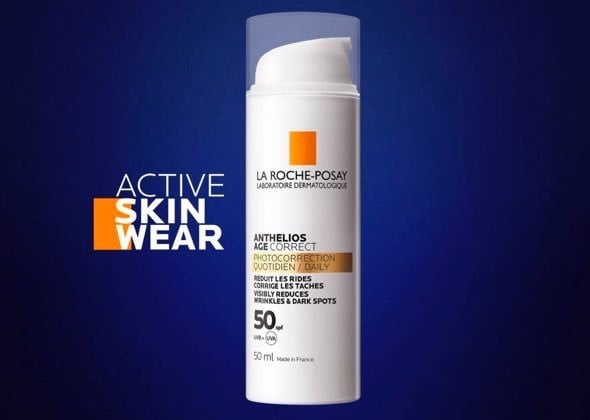WHERE DOES ATOPIC DERMATITIS
COME FROM?
Many individuals have a genetic predisposition to atopic dermatitis, which means atopic dermatitis (or atopic eczema) can run in families. Those who are affected by this disorder have a highly reactive immune system and are prone to allergic conditions such as asthma and allergic rhinitis. Atopic skin is dry by nature. Normal skin produces an oily film to protect itself, whereas atopic skin doesn’t (but don’t worry, we’re here to help you!) This is known as the “cutaneous barrier” or “barrier function” of the skin. Eczema-prone skin is as though “stripped bare”, so some allergens in our environment are able to deeply penetrate into the lower epidermal layers. They then stimulate the immune system, which overreacts. This causes clinical signs of atopic eczema to appear: itchiness, inflammation and oozing. Environmental factors such as pollution may also explain the significant increase in atopic dermatitis over the past few years. There is even evidence that an imbalance in skin’s friendly bacteria may be a factor in atopic eczema.
WHAT ARE THE SYMPTOMS OF
ATOPIC DERMATITIS?
Eczema on the face
Atopic eczema is very dry skin that feels tight and itchy. It appears mainly on the face in babies. Symptoms of atopic dermatitis on the face also include flakiness and rough red patches. The visible signs of atopic eczema on the face can have a genuine impact a child’s well-being as he or she can feel embarrassed or anxious in public. The good news is that with the right treatment and daily care routine in between crisis, your child’s atopic eczema can be effectively managed almost to the point of becoming a non-issue.
Eczema on the body
In newborns, atopic dermatitis is most frequently found on the face, particularly the cheeks and chin. As the child gets older, the eczema patches become located mainly on the neck and in the skin folds around the elbows, wrist and behind the knees. The symptoms include patches of dry, intensely itchy skin, often with visible scratch marks. Over time, the skin can become thick and leathery in a process called “lichenification.” If your child has any of those symptoms, consider seeing your GP or dermatologist.
WHEN DOES ATOPIC DERMATITIS
START?
Eczema in babies
Atopic dermatitis or atopic eczema often appears during the first few months of life. Baby atopic prone skin is managed using soap substitutes (syndets) for washing and emollients. Do not hesitate to use an emollient specifically adapted to atopic prone skin from the very first days your baby is born.
Can I cure my child’s atopic eczema?
In 50% of cases of children with atopic eczema before the age of 1, the condition disappears on its own by the age of 5. There is no definitive cure, but the very dry skin condition can be managed with certain measures such as using a soap substitute to wash, favouring lukewarm showers over hot baths, and applying an emollient twice daily. Acute flare-ups can be managed with topical corticosteroid creams, but these are to be used for limited periods of time only as they can cause side effects such as thinning of the skin. See below for an in-depth analysis of atopicprone skin routine.
ATOPIC ECZEMA:
A GENUINE IMPACT ON A CHILD’S LIFE
Eczema in babies
The primary symptom of atopic dermatitis is “pruritus” or itching, which impacts children’s well-being. Frequent issues include disturbed sleep, mood swings and permanent discomfort.
When a child has atopic skin, the whole family feels the effects:
• 58% of atopic children experience disturbed sleep1,
• 31% of parents state that they make changes to their everyday life2 ,
• 85% of parents feel that their child's illness has an impact on their own emotional state3.
DON’T SCRATCH. INSTEAD,
SOOTHE THE ITCHING
While scratching can temporarily relieve the itch, it will only maintain the eczema as scratching skin further damages its protective barrier. The result is a highly frustrating itch-scratch cycle. To break the vicious circle of atopic dermatitis or eczema, it is therefore important to soothe this itchiness.
Read on to discover lifestyle tips to reduce that infuriating itch, followed by a guide to treatments your doctor may prescribe during flare-ups.
5 TOP TIPS
FOR A LESS ITCHY LIFE!
1. Cleanse atopic prone skin gently
Opt for lukewarm showers over baths and limit them to 10 minutes max. Avoid foaming products which can be harsh on skin and opt instead for soap-free cleansers such as Syndets that cleanse the skin without causing irritation. Also, be sure to use shampoos suitable for the most sensitive skin after 3 years old. After every shower, apply an emollient specifically created for atopic proneskin.
2. Got atopic prone skin? Wage war on the dust mite!
Atopic eczema is associated with very dry skin lacking the lipids that protect normal skin against certain external allergens such as house dust mite. Vacuum regularly and air rooms daily, particularly bedrooms. If necessary, purchase mattress protectors and pillows that are specifically designed to prevent dust mites.
3. Ensure restorative sleep
Atopic prone skin is characterized by a dry skin condition triggering itching which can disturb children during the night… and their parents too! Help everyone to get a good night's sleep by maintaining the bedroom temperature between 18 and 20 degrees: This will prevent the atmosphere from becoming too dry. If necessary, purchase air humidifiers. And, of course, make sure you apply emollient in the evening.
4. Cotton is the ideal clothing material for atopic prone skins
When you have a dry skin, it is essential to avoid excessive sweating, which could cause irritation. Wool and synthetic fabrics should be avoided. Instead opt for breathable cotton, which is softer on the skin. And if you like to work up a sweat while doing exercising, then…
5. Enjoy sport but shower straight after
Exercise is not off-limits in eczema-prone skins but beware of leaving sweat on skin for prolonged periods, as it can cause irritation. The best approach is to wear loose-fitting, breathable clothing that wicks sweat away from the skin. After your exercise session, shower immediately using a suitable cream wash and follow up with an emollient for atopic prone skin. Your emollient should moisturise the skin and rebalance its friendly bacteria.
WHO TREATS ATOPIC DERMATITIS
WHEN LIFESTYLE CHANGES AREN’T ENOUGH?
If you think your child may have eczema, the specialist best suited to dealing with the problem is a dermatologist. Only they will be able to provide an accurate diagnosis, prescribe treatment and give appropriate advice. Milder cases of atopic dermatitis can also be managed by your primary care doctor (GP) and it’s always worth asking your pharmacist for advice on appropriate treatments.
UNDERSTANDING YOUR
ATOPIC DERMATITIS ROUTINE
Eczemadaily care basically falls into two categories: treatment for flare-ups and maintenance care between flare-ups.
Atopic eczema flare-up treatment
When atopic dermatitis symptoms are severe (dry red patches, scratch marks, various imperfections…) dermatologists prescribe corticosteroid creams. These eczema treatments have an anti-inflammatory action and should therefore be applied to inflamed parts of the skin to soothe and reduce damage from scratching as soon as possible. Twice-daily application of corticosteroid is generally recommended. Concerned about how safe they are? Read on…
Steroid creams are safe if used correctly
In some countries, cortisone is unpopular due to its supposed side effects: water retention, sleep disorders, a slower growth rate, etc. However, these phenomena only concern corticosteroids administered orally.
When in cream form, the steroid remains on the skin surface and does not cause these severe side effects. However, caution is advised as overuse of topical steroids can thin and weaken the skin. Steroid creams are not recommended on the face, where the skin is thinner.
Maintenance phase with emollients
Maintenance between flare ups is an essential part of dealing with an atopic prone skin.
Once the atopic eczema lesions have disappeared, emollient creams restore the oil-in-water emulsion that protects skin’s surface (the “hydrolipidic film” or “cutaneous barrier” we mentioned above) and limit the penetration of irritants.
Creams for atopic prone skin should be applied to the entire body once or twice a day to moisturise skin and rebalance its friendly bacteria thus reducing itching due to dryness and preventing further flare-ups from occurring or limiting their duration. By keeping skin moisturised and protected with a rich emollient, you can stop environmental nasties from bothering your skin, allowing you to break the itch-scratch cycle.
THE IMPORTANCE OF COMPLIANCE TO ATOPIC DERMATITIS
TREATMENT AND DAILY SKINCARE ROUTINE
Since atopic eczema is a chronic skin condition, the key to successful care is consistency. It is important to be vigilant and keep on the lookout for new red patches that may need steroid cream treatment, as well as being absolutely meticulous about your maintenance routine.
For daily washing, use tepid water and a soap substitute or Syndet, and follow up with an emollient specifically for atopic prone skin. A suitable emollient such as Lipikar Baume AP+ should be applied at least once a day. Also, don’t hesitate to show your dermatologist how you apply the creams correctly on your child.
GET YOUR CHILD
INVOLVED!
Since you’re going to be applying emollient twice a day, it’s always going to be easier if you can make it fun! Consider putting on your child’s favourite music as you apply the ointment, or why not make up a cream application song or apply cream in patterns? The important thing is that your child is motivated to consistently take care of his/her eczema as part of a regular morning and bedtime routine. Don’t hesitate to give your child a little autonomy - he/she might just surprise you!
ATOPIC ECZEMA
AND THE BACTERIA THAT LIVE ON SKIN
Healthy skin is home to billions of friendly bacteria happily living on every square millimetre. By contrast, atopic dermatitis is associated with a depletion in the diversity of these micro-organisms (bacteria, fungi, archaea…), known as the microbiome. Up until now, we have tried to eradicate the micro-organisms present in our body and on the surface of our skin. Yet recent research has shown that, actually, these micro-organisms constitute a balanced bacterial heritage which interacts with our body in order to ensure that it functions correctly. It just so happens that in eczema the microbiome is unbalanced.
REPLENISHING THE MICROBIOME
IN ORDER TO TACKLE ATOPIC PRONE SKIN
The best emollient for atopic prone skin thus replenishes both skin’s lipid barrier and rebalances its microbiome. In a clinical study, La Roche-Posay laboratories have demonstrated that it is not enough to simply restore skin’s barrier function in order to provide lasting relief for atopic prone skin. It is equally important to restore the balance of the microbiome. With Lipikar Baume AP+ you can simultaneously replenish skin’s lipids and rebalance the microbiome to offer your child immediate relief and a 24-hour anti-scratch effect as well as spacing out the frequency of dry patches flare-ups.
A DAILY CARE ROUTINE
FOR CHILDREN
WITH ATOPIC ECZEMA PRONE SKIN
What daily care products are suitable for atopic prone skin?
When bathing/showering children with atopic prone skin, opt for suitable products such as LIPIKAR Syndet : it helps restore the comfort and well-being of children with dry skin condition. Using your fingertips, work this syndet, or "soap-free soap", into a lather. Rinse thoroughly. It’s also fragrance-free.
While skin is still moist, apply Lipikar Baume AP+ a rich emollient that works on skin’s lipid barrier and helps rebalance its microbiome.
LIPIKAR BAUME AP+:
GROUNDBREAKING ACTIVE INGREDIENTS
IN A FAST-ABSORBING TEXTURE
Specifically created for atopic prone skin, Lipikar Baume AP+ contains a combination of active ingredients selected for their effectiveness against severe dryness and for atopic prone skin in a revolutionary new texture that facilitates regular application. The new LIPIKAR Baume AP+ preparation has demonstrated its efficacy in:
1. Restoring long-term balance to the microbiome
LIPIKAR Baume AP+ formula (a preparation made from a friendly bacteria grown in La Roche-Posay Thermal Spring Water) helps to restore balance to the diversity of the micro-organisms living atskin’s surface, its microbiome. It keeps skin stable during periods of remission to prevent relapses. It soothes irritation, strengthens the skin barrier to limit introduction of pathogenic agents that would cause new irritation and promotes the reconstruction of the cutaneous barrier.
2. Replenishing skin’s lipid barrier
LIPIKAR Baume AP+ contains a combination of reference active dermo-cosmetic ingredients to moisturise atopic prone skin for an intense emollient effect:
• Shea butter, naturally lipid-replenishing
• Canola oil, lipid-replenishing
• Glycerin, moisturising and smoothing
3. Soothing effect
Niacinamide acts directly to soothe irritation in atopic prone skin. It calms and soothes itching sensations while reducing discomfort.
LA ROCHE-POSAY, TEAMING UP
WITH YOU FOR ATOPIC PRONE SKINS’ SAKE
La Roche-Posay laboratories develop products specifically for atopic prone skins, which are to be used from the first stages of life. By creating products tailor-made for atopic eczema-prone skin, La Roche-Posay works to improve the quality of life of children affected by the condition - and their families.
Beyond the products, La Roche-Posay runs over 80 atopy schools across the world to improve the quality of life of children with atopic skin and make them feel less isolated. One such school is run at the La Roche-Posay Thermal Centre, Europe’s n°1 dermatological thermal centre where thousands of eczema patients are treated each year4.
At the atopy schools, together with their parents, children can take part in workshops on how to apply ointment and learn how to take care of their skin. They receive advice about how to avoid scratching their skin and learn the best ways to apply emollient in a fun and relaxed environment.
1Clinical study, 209 children aged between 2 and 16 (average age: 8) with mild to moderate atopic dermatitis
2Dimension Baromètre suivi dermatologue 2008, Fr-All-It-Esp [Measurement: Dermatologist monitoring poll 2008, France-Germany-Italy-Spain]
3La Roche-Posay clinical study, at 8 sites (France, Italy, Belgium, Germany, Argentina), 191 child patients aged between 3 and 22 having had atopic dermatitis for 5 years on average.
4Certifications awarded to La Roche-Posay thermal cure as a result of the Europe-wide examination and surveys which ESPA have carried out in 2018







